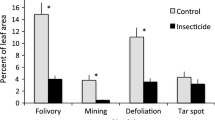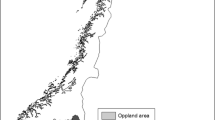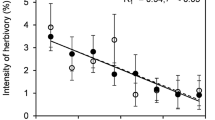Abstract
If a browse damage index indicates that a tree has been 50% browsed by herbivores, does this mean half the leaves are entirely eaten or are all the leaves half eaten? Were the affected leaves old or young? Large or small? In sunshine or shade? Understanding what effect browsing will have on the photosynthetic capacity and the plant’s survival ability clearly requires a greater understanding of browsing strategy across the canopy than can be given by a single index value. We developed stochastic models of leaf production, growth and consumption using data from kamahi (Weinmannia racemosa) trees in New Zealand which have been browsed by possums (Trichosurus vulpecula), to ascertain which of six feasible browsing strategies possums are most likely to be employing. We compared the area distribution of real fallen leaves to model output in order to select the best model, and used the model to predict the age distribution of leaves on the tree and thus infer its photosynthetic capability. The most likely browsing strategy that possums employ on kamahi trees is a preference for virgin (i.e. previously unbrowsed) leaves, consistent with the idea that browsing increases the production of chemical plant defences. More generally, our results show that herbivore browsing strategy can significantly change the whole-plant photosynthetic capability of any plant and hence its ability to survive, and therefore, herbivore damage indices should be used in conjunction with more detailed information about herbivore browsing strategy.





Similar content being viewed by others
References
Appel H, Cocroft R (2014) Plants respond to leaf vibrations caused by insect herbivore chewing. Oecologia 175:1257–1266
Brown BJ, Allen TFH (1989) The importance of scale in evaluating herbivory impacts. Oikos 54(2):189–194
Burnham KP, Anderson DR, Burnham KP (2002) Model selection and multimodel inference: a practical information-theoretic approach, 2nd edn. Springer, New York
Chabot BF, Hicks DJ (1982) The ecology of leaf life spans. Annu Rev Ecol Systematics 13:229–259
Choinski J Jr, Gould K (2010) Immature leaves of Weinmannia racemosa are more heat tolerant than mature leaves based on differences in chlorophyll a fluorescence and solute leakage. N Z J Bot 48:163–177
DeGabriel JL, Moore BD, Foley WJ, Johnson CN (2009) The effects of plant defensive chemistry on nutrient availability predict reproductive success in a mammal. Ecology 90:711–719
DeMay SM, Roon DA, Rachlow JL, Cisneros R (2014) Selective foraging on bromeliads by Andean bears in the Ecuadorian páramo. Ursus 25:139–147
Department of Conservation (2014) The Foliar Browse Index field manual. An update of a method for monitoring possum (Trichosurus vulpecula) damage to forest communities. Christchurch, New Zealand
Field C, Merino J, Mooney HA (1983) Compromises between water-use efficiency and nitrogen-use efficiency in five species of California evergreens. Oecologia 60:384–389
Forsyth DM, Parkes JP (2005) Browse on mahoe and kamahi leaf-fall as a trigger for possum control. N Z J Ecol 29:311–320
Freeland WJ, Janzen DH (1974) Strategies in herbivory by mammals: the role of plant secondary compounds. Am Nat 108(961):269–289. doi:10.1086/282907
Givnish TJ (1988) Adaptation to sun and shade: a whole-plant perspective. Funct Plant Biol 15:63–92
Gormley AM, Holland EP, Pech RP, Thomson C, Reddiex B (2012) Impacts of an invasive herbivore on indigenous forests. J Appl Ecol 49:1296–1305
Green T, Jane G (1983) Changes in osmotic potential during bud break and leaf development of Nothofagus menziesii. Weinmannia racemosa, Quintinia acutifolia, and Ixerba brexioides N Z J Bot 21:391–395
Holland EP, Pech RP, Ruscoe WA, Parkes JP, Nugent G, Duncan RP (2013) Thresholds in plant-herbivore interactions: predicting plant mortality due to herbivore browse damage. Oecologia 172:751–766. doi:10.1007/s00442-012-2523-5
Hörnberg S (2001) Changes in population density of moose (Alces alces) and damage to forests in Sweden. For Ecol Manag 149:141–151
Kitajima K, Mulkey S, Wright S (1997) Decline of photosynthetic capacity with leaf age in relation to leaf longevities for five tropical canopy tree species. Am J Bot 84:702–702
Kitajima K, Mulkey SS, Samaniego M, Wright SJ (2002) Decline of photosynthetic capacity with leaf age and position in two tropical pioneer tree species. Am J Bot 89:1925–1932
Kot M (2001) Elements of mathematical ecology. Cambridge University Press, Cambridge
Koyama K, Kikuzawa K (2009) Is whole-plant photosynthetic rate proportional to leaf area? A test of scalings and a logistic equation by leaf demography census. Am Nat 173:640–649
Lambdon P, Hassall M (2005) How should toxic secondary metabolites be distributed between the leaves of a fast-growing plant to minimize the impact of herbivory? Funct Ecol 19:299–305
McArthur C, Banks PB, Boonstra R, Forbey JS (2014) The dilemma of foraging herbivores: dealing with food and fear. Oecologia 176:677–689
Moore BD, Lawler IR, Wallis IR, Beale CM, Foley WJ (2010) Palatability mapping: a koala’s eye view of spatial variation in habitat quality. Ecology 91:3165–3176
Nugent G, Sweetapple P, Coleman J, Suisted P (2000) Possum feeding patterns: dietary tactics of a reluctant folivore. In: Montague TL (ed) The brushtail possum: biology, impact, and management of an introduced marsupial, Manaaki Whenua Press, Lincoln, New Zealand, pp 10–23
Palacio S, Hester AJ, Maestro M, Millard P (2013) Simulated browsing affects leaf shedding phenology and litter quality of oak and birch saplings. Tree Physiol 33(4):438–445
Parsons K, Quiring D, Piene H, Moreau G (2005) Relationship between balsam fir sawfly density and defoliation in balsam fir. For Ecol Manag 205:325–331
Payton I (2000) Damage to native forests. In: TL Montague TL (ed) The brushtail possum: biology, impact and management of an introduced marsupial. Manaaki Whenua Press, Linvoln, pp 111–125
Payton I, Forester L, Frampton C, Thomas M (1997) Response of selected tree species to culling of introduced Australian brushtail possums Trichosurus vulpecula at Waipoua Forest, Northland, New Zealand. Biol Conserv 81:247–255
Provenza FD, Villalba JJ, Dziba L, Atwood SB, Banner RE (2003) Linking herbivore experience, varied diets, and plant biochemical diversity. Small Rumin Res 49:257–274
Richardson SJ, Peltzer DA, Allen RB, McGlone MS (2010) Declining soil fertility does not increase leaf lifespan within species: evidence from the Franz Josef chronosequence, New Zealand. N Z J Ecol 34:306–310
Rose AB, Pekelharing CJ, Platt KH (1992) Magnitude of canopy dieback and implications for conservation of southern rata-kamahi (Metrosideros umbellata-Weinmannia racemosa) forests, central Westland, New Zealand. N Z J Ecol 16(1):23–32
Roy N, Barik A (2012) The impact of variation in foliar constituents of sunflower on development and reproduction of Diacrisia casignetum Kollar (Lepidoptera: Arctiidae). Psyche J Entomol 2012
Sessions LA, Kelly D (2001) Heterogeneity in vertebrate and invertebrate herbivory and its consequences for New Zealand mistletoes. Austral Ecol 26:571–581
Shaffer CA (2014) Spatial foraging in free ranging bearded sakis: traveling salesmen or Lévy walkers? Am J Primatol 76:472–484
Shirke P (2001) Leaf photosynthesis, dark respiration and fluorescence as influenced by leaf age in an evergreen tree. Prosopis juliflora Photosynth 39:305–311
Speed MP, Fenton A, Jones MG, Ruxton GD, Brockhurst MA (2015) Coevolution can explain defensive secondary metabolite diversity in plants. New Phytol 208:1251–1263
Stewart G, Rose A (1988) Factors predisposing rata-kamahi (Metrosideros umbellata–Weinmannia racemosa) forests to canopy dieback, Westland, New Zealand. GeoJournal 17:217–223
Stone C, Matsuki M, Carnegie A (2003) Pest and disease management in young eucalypt plantations: field manual for using the Crown Damage Index. National Forest Inventory, Bureau of Rural Sciences, Canberra
Taiz L, Zeiger E, Møller IM, Murphy A (2015) Plant physiology and development. Sinauer Associates Incorporated, Sunderland
Wardle P, MacRae A (1966) Biological flora of New Zealand 1. Weinmannia racemosa Linn. F. (Cunoniaceae). Kamahi. N Z J Bot 4:114–131
Acknowledgements
Leaf material was collected in the field by Caroline Thomson and Roger Carran. Peter Sweetapple, Amie Sweetapple and Vanessa Lattimore sorted the leaves. Bridget Thomas scanned the leaves and ran the software for calculating leaf area. Roger Pech gave useful comments on the manuscript. Julie Mugford was supported by a University of Canterbury summer student scholarship, in conjunction with Landcare Research. The work was funded in part by ’core’ funding for Crown Research Institutes from the Ministry of Business, Innovation and Employment’s Science and Innovation Group (contract CO9X0909).
Author information
Authors and Affiliations
Corresponding author
Rights and permissions
About this article
Cite this article
Holland, E.P., Mugford, J., Binny, R.N. et al. How Herbivore Browsing Strategy Affects Whole-Plant Photosynthetic Capacity. Bull Math Biol 79, 772–787 (2017). https://doi.org/10.1007/s11538-017-0253-x
Received:
Accepted:
Published:
Issue Date:
DOI: https://doi.org/10.1007/s11538-017-0253-x




